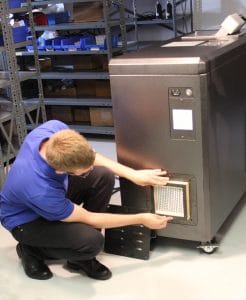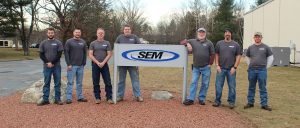Data destruction devices are pretty simple when it boils down to purpose: destruction – put a drive in, it gets shredded. With that in mind, how important is maintenance? Just like with all machines, maintenance is vital with data destruction devices, and the machines need to be periodically checked and serviced to make sure that they are running safely and properly.
Types of Maintenance Needed
An IT data destruction device is made to disintegrate, shred, or crush drives; as a result, they generally have trays to catch any bits of drive that missed the take-away conveyors. These bits can be harmful to the longevity of the machine if they are left in the tray, so the trays should be emptied daily to increase the lifespan of the machine. Furthermore, the backs of the devices can get buildups of metal fragments, which need to be cleaned out. In the case of HDD shredders, the cutting heads should be checked for excess magnet buildup. These are all fairly simple tasks, and if possible should be taken care of daily to help increase the health of the machine.
For more in-depth maintenance, technicians should check the machines about three times a year. Essentially, they will take a look around the interior of the machines and clean it out whilst also making sure that everything is running as it should be. The technicians will also lubricate the important parts of the machines to ensure everything runs smoothly.
Why Maintenance Matters
Maintenance is vital for the shredders and crushers, like it is with most machines. The first and simplest reason for its importance is if the machine isn’t running properly, it could function poorly, and data could be recovered from improperly destroyed drives. In that case, a data breach happens, and you could be held accountable for the negligence. On top of that, if the machine isn’t properly taken care of, it could become slower and sluggish, and could even break down completely. In that case, your data destruction programs stops and that you cannot dispose of safely. Lastly, a machine that is not serviced can become damaged, whether from dull blades adding strain onto the motor or loose belts allowing too much gear movement or any number of issues. Repairing a damaged machine is far more costly than preventing the damage in the first place with a scheduled maintenance plan. Maintenance is a simple way to save money in the long term. By ensuring your machines are in tip top shape, you grant them the longest lifespan possible, which in turn means not spending unnecessary money on costly repairs or new machines when the older ones could still be running perfectly well. While technician check-ups cost money short term, the money saved in the long run easily provides a significant return on investment.
Maintenance is a simple way to save money in the long term. By ensuring your machines are in tip top shape, you grant them the longest lifespan possible, which in turn means not spending unnecessary money on costly repairs or new machines when the older ones could still be running perfectly well. While technician check-ups cost money short term, the money saved in the long run easily provides a significant return on investment.
The day to day maintenance will eventually become routine and simple, and you will get a feel for the machine and know when the daily maintenance is done. For the less routine maintenance, factory authorized service technicians will be able to determine parts that need maintenance, such as worn belts or cutters, misaligned gears, or any number of mechanical issues. Their eyes are trained to see problems or potential issues with the machines, and they will be able to see things that the operators cannot.
To Summarize
Maintenance is extremely important for data destruction devices. There is the daily maintenance, which becomes routine and is fairly simple to do. There is also the more technical maintenance, where service technicians come in for routine service. Both types of maintenance are vital to the machine to ensure maximum lifespan and to ensure everything is running properly, and, most importantly, is safely destroying your data.



